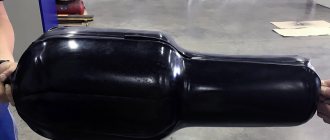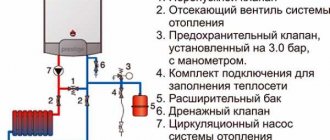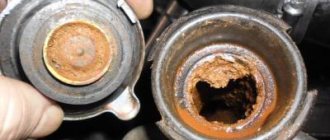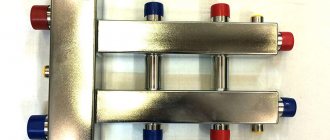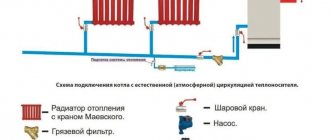A car engine, like any internal combustion engine, heats up during operation, so it needs to be constantly cooled. Cooling systems are designed for this purpose. According to the principle of operation, they are of two types: liquid and air. The first ones are most widespread, although they are more complex structurally. “Air vents”, despite their simplicity, are much more prone to overheating. Since all engines today operate with liquid cooling, in the engine compartment of any car there is a small container made of translucent plastic with a lid, designed for pouring antifreeze. This is the expansion tank of the engine cooling system. For different engines, the volume of the expansion tank ranges from 1.5 to 8 liters.
Why do you need an expansion tank?
What is the expansion unit used for?
The fact is that any liquid increases in volume when heated. Thus, the volume of water when heated to 100°C increases by 4.5%, antifreeze and antifreeze - by up to 6%. To prevent the coolant from pouring out of the system when it is heated, an expansion tank is needed, which is a kind of buffer or compensator. Until the middle of the last century, there were no expansion tanks under the hood, since ordinary water was used as coolant, and the role of a compensator was played by the upper radiator tank, which was not topped up “to capacity.” With the advent of ethylene glycol-based coolants (antifreeze), the coefficient of volumetric expansion of which is greater than that of water, additional expansion tanks appear so as not to enlarge the radiator.
Digator cooling system design
Thus, the expansion tank (EB) is designed to compensate for the volumetric expansion of the coolant as its temperature increases. The RB is located in the engine compartment so that the fluid level is approximately at the middle of the height of the tank. In this case, the liquid in the radiator and tank is located at the same level according to the principle of communicating vessels. Since the RB is located above the radiator, the expansion tank cap is used as a filler neck, which will be discussed below.
The car boiled - consequences
If the system is boiling, the degree of damage to the channels varies. Often this does not threaten anything dangerous, the owner of the car is simply limited by fear. But if an overheated engine stalls (and the battery has nothing to do with it), this may indicate the following things:
- destruction of the cylinder head seal;
- block damage;
- critical decrease in antifreeze level;
- damage or deformation of valves;
- Damage to valve stem seals.
Cylinder head destruction
The consequences of boiling are eliminated depending on the specific situation. Usually everything is solved by restoration and grinding of the cylinder head. Seizing of pistons in liners is rare. However, in this case, repairs seem impractical. It is much easier and cheaper to install another motor.
Constant overheating of the liquid and the release of steam is a symptom of a decrease in the amount of coolant. In this case, the engine will not cool properly even after cooling. If you do not take measures to refuel and simply cool the unit, the antifreeze will boil again. Heating in the area of combustion chambers and other heat-loaded parts will increase. The internal parts of the unit will become unusable, and the cylinder block itself will collapse.
Design and operation
The expansion tank consists of a polypropylene body, a cover and two pipes for connecting hoses of the liquid system.
Using the lower hose, the device is connected to the cooling line, the upper one serves to remove vapors and air bubbles from the system. On modern models, float coolant level sensors are often installed. For this option, the expansion tank is equipped with another neck on top, intended for installing a sensor. Several control marks are applied on the side surface of the container, from the bottom - min to the top - max. The coolant level should be located in this interval.
How does the device work? First, a little theory. The table shows the operating temperature conditions of modern engines
. As we can see, the engines operate in critical temperature conditions.
To raise the bar for permissible temperature, designers increase the pressure in the coolant (more than atmospheric), due to which its boiling point increases. To do this, the system is closed hermetically and excess pressure is maintained in it. For different engines, this value ranges from 0.1 to 0.5 bar (kg/cm²).
At the same time, significant vacuum (more than 0.03 - 0.1 kg/cm²) in the free space of the expander is unacceptable, since air will be sucked into the system, which will lead to the appearance of air pockets that impede coolant circulation and, consequently, to engine overheating . Maintaining the coolant pressure at the required level is the responsibility of a special regulator located in the filler cap.
Recommendations for selection
For VAZ 2110-12 models, you can find 2 types of expansion tanks on sale:
- old model with two necks: the coolant level sensor is screwed into the first, and the second is closed with a plug with a release valve;
On old-style products, a second neck was made for installing an antifreeze level sensor
The new sample container does not have a level sensor
If your car has a sensor in an expansion tank, then you need to select an old-style product. Accordingly, versions without a sensor will require a new reservoir design.
For VAZ 2114-15 models, tanks of the same shape are offered with 3 fittings: two of them are located at one end, and the third is located at the opposite end. Products for the VAZ 2110 and 2114 are not interchangeable with each other, although if you really want to, attaching a part from another model is quite possible. Another thing is that there is no need for this - both varieties are available for free sale and practically do not differ in price.
The reservoir for models 2114-15 has a wider shape and a versatile arrangement of fittings
When purchasing an expansion tank for any series of cars of the “tenth” family, pay attention to the following points:
- the plastic of a quality product should be light and half transparent;
- cracks in the corners or near the fittings are unacceptable;
- the plastic should not be “oaky” or have dark impurities visible to the naked eye;
- look on the body for an imprint of the manufacturer's trademark and catalog number (21083–1311014 for VAZ 2114).
Tank cover - two in one
So, the RB cover, in addition to its protective function, also performs the task of a pressure regulator.
As stated above, the pressure inside the tank should be up to 1.1 - 1.5 kg/cm². How is this achieved? For this purpose, two valves are mounted in the lid: safety and vacuum. The first is a spring-loaded rubber diaphragm that is pressed from the outside and releases when the pressure exceeds the force of the spring. The second consists of a rubber washer with a small spring installed inside a large one.
At operating coolant temperature, both valves are closed, the pressure in the tank does not exceed the design pressure. Since the expansion tank is hermetically sealed, the pressure increases as the temperature rises, causing the safety valve to open and release some of the air vapor, returning the valve to its previous position.
The absence of a safety mechanism would lead to coolant leaks, damaged connections, and even rupture of the cooling radiators and heater.
After stopping the engine, the liquid in the system cools and decreases in volume, which leads to a vacuum inside the tank. The result may be air leaking through the connections, which will lead to the formation of air bubbles during subsequent startup. And this can lead to overheating and engine failure.
This is where another small valve comes to the rescue - a vacuum valve. Under the influence of vacuum, it opens and equalizes the pressure in the tank with atmospheric pressure.
DIY water cooling for PC
If they want to experiment a little and save money, many people try to create homemade liquid coolers from improvised materials. Let's look at an example of how to assemble an SVO at home:
- It is better to purchase a factory-made water block; homemade ones leak more often and dissipate heat worse.
- Hoses can use clear vinyl or oxygen tubing.
- It is advisable to take a pump with a capacity of 600 l/h or more.
- The radiator is suitable for a car or another old model of suitable sizes.
- Additionally, purchase a pair of fans with dimensions of 120 mm or 140 mm.
- To ensure that the water cooling system operates without leaks, select the clamps according to the size of the hose and clamp them as tightly as possible.
- After assembly, fill the PC water cooling with water and turn on the pump for several hours to detect leaks.
- Install the SVO on your computer and check its performance in test mode.
Expansion tank malfunctions and causes
Decrease in coolant level:
- leakage of the plastic body of the tank due to aging of the material, in particular, this was a chronic disease of the tanks of VAZ cars;
- The safety valve does not work, as a result of which increased pressure squeezes antifreeze through the joints.
Engine overheating:
- due to decreased volume of liquid due to leaks;
- The vacuum valve does not work, resulting in air appearing in the liquid (“airing”).
Visible fluid leaks:
- expansion tank is leaking;
- safety valve malfunction.
Liquid cooling
The structure of liquid cooling is as follows:
• cooling jacket; • fan; • diffuser; • pump; • interior heater; • thermostat; • rubber pipes; • expansion tank.
The heated antifreeze is moved through the outlet pipes to the engine radiator compartment, where excess thermal energy is collected and then, the already cooled mixture, is supplied to the cylinder block jacket. The cooler circulation is carried out due to the presence of a pumping device (pump), and heat is removed from the radiator core due to the air flow passing through the honeycombs of the device. The efficiency of heat removal is controlled by a thermostat and a fan start relay.
To fill cooling systems, alcohol-containing low-freezing liquids – antifreeze – are used. The amount of antifreeze poured depends on the type of vehicle and the performance of the unit (2–15 l). To drain antifreeze in the engine housing, there are plugs located in the body of the cylinder block and the lower section of the radiator.
Checking the functionality of the lid
Simplified test: are the valves working?
We start the engine and, being careful, unscrew the cap: if you hear the hissing sound of a deflated chamber, the bypass valve is working (however, whether it is correct or not is unknown).
After removing the cover, squeeze any hose of the cooling system with your hand. Continuing to hold it in this way, put the cover in place. If it then regains its shape, the vacuum appears to have been filled. But if, even before starting the engine, the hoses look like they are flattened, the vacuum valve is definitely not working.
More accurately, the safety valve can be checked using a pump and pressure gauge. We connect the pump to the lower supply pipe of the tank, and plug the upper one using improvised means: a bolt or a cylindrical drill that fits tightly into the supply hose.
We create pressure with the pump and control the moment when the safety valve is activated (hissing sound). The pressure value recorded on the device scale shows the actual response pressure.
If the safety valve is too tight, it can be repaired. Why spend extra money when it is enough to shorten the pressure spring by one or two turns, and the spring will become softer. The assembly is easy to disassemble, the main thing is not to lose small parts. And don't overdo it by biting off the coils. Do this little by little and check the results.
What is the best way to cool processors?
CBO-based solutions provide increased cooling efficiency compared to a standard motherboard CPU cooler. However, the decision of which type of cooling to use is usually influenced by several factors: price, compatibility and appearance.
Although liquid cooling is superior to air cooling in various scenarios, you need to understand why such a system is needed. For example, there is no reason to use liquid cooling unless your processor runs hotter than recommended. There's also no reason to use heavy-duty air cooling if you're not even gaming. Sometimes it is enough to limit yourself to good passive cooling with a cooler that is tolerant in terms of noise characteristics.
If you decide to install a water cooler, keep in mind that there are several ways to water cool a PC, and the method you choose will depend on your technical experience and, of course, your budget.
Adding coolant
The liquid level in the tank is controlled by two extreme marks: min and max. How to properly add coolant to the expansion tank:
- Check the fluid level on a cold or cooled engine (let it cool thoroughly).
- Open the RB cover (if the engine is not cool enough, grab the cover with a rag) and slowly turn it until steam comes out.
- Add liquid without reaching the max mark.
- Close the lid and start the engine with the heating off. Warm up the engine for about 3 minutes at 2000 rpm and wait until the forced cooling fan turns on.
- Check the coolant level and add it to the max mark.
A little advice:
monitor the external condition of the tank and all elements of the cooling system. Fluid leaks in the engine compartment often indicate a malfunction of the expansion tank, primarily the cap.
As follows from what has been written, it actually depends on such a seemingly secondary unit as the expansion tank of the cooling system how stably the engine of your car will operate.
If you notice an error, inaccuracy or want to supplement the material, write about it in the comments and we will correct the article!
Key tags: engine, car device
The car boiled - consequences
If the system is boiling, the degree of damage to the channels varies. Often this does not threaten anything dangerous, the owner of the car is simply limited by fear. But if an overheated engine stalls (and the battery has nothing to do with it), this may indicate the following things:
- destruction of the cylinder head seal;
- block damage;
- critical decrease in antifreeze level;
- damage or deformation of valves;
- Damage to valve stem seals.
Cylinder head destruction
The consequences of boiling are eliminated depending on the specific situation. Usually everything is solved by restoration and grinding of the cylinder head. Seizing of pistons in liners is rare. However, in this case, repairs seem impractical. It is much easier and cheaper to install another motor.
Constant overheating of the liquid and the release of steam is a symptom of a decrease in the amount of coolant. In this case, the engine will not cool properly even after cooling. If you do not take measures to refuel and simply cool the unit, the antifreeze will boil again. Heating in the area of combustion chambers and other heat-loaded parts will increase. The internal parts of the unit will become unusable, and the cylinder block itself will collapse.
Popular brands:
Volkswagen Passat
Results
Initially, it is necessary to determine the volume of the tank for expansion, and only after that decide what type to purchase, open or closed. Installation of the entire system must be carried out by qualified specialists. Self-connection is not allowed. During the work, the installation team will make sure that all components and assemblies of the system are installed in accordance with safety requirements and correct installation. In addition, the home owner will be provided with a guarantee on materials and work performed. Therefore, if problems arise, the homeowner can seek help from the place where he ordered the project.
Various types of containers
There are various designs of expansion tanks. They vary in size and shape. You can determine which vessel is needed by calculating its data. Also, when choosing a unit, you should take into account the type of heating system installed in the house. The form factor of the tanks is represented by a tablet, as well as a cylindrical shape.
Expansion tank in the form of a tablet
The different appearance depends on the method of use. The customer can purchase:
- Open type tank;
- Closed tank with built-in membrane.
Closed tanks without a built-in membrane are also available. However, experts recommend refraining from using this type of tank in home heating systems. Unfortunately, the design features of this product require careful refinement. The movable partition in such tanks is replaced by an air mass. Thus, air will be allowed to enter the internal heating system of the house, and the presence of air in the circuit is unacceptable. In such a tank, the water level will increase all the time until it reaches a critical point.
What function does antifreeze perform?
First of all, it should be recalled that the word “antifreeze” has foreign roots and is translated as “anti-freeze.” This is how one can characterize its main function. This substance should not freeze even in very frosty winters.
In addition, the coolant performs the following work:
- fast and effective protection of the car engine from overheating during its operation;
- maintaining a high level of anti-corrosion protection for all existing metal parts;
- reliable protection of the cooling system from freezing when using the car in the frosty winter period.
What are the advantages of a closed heating system
A closed heating main has a number of advantages over an open one. Namely:
- this type of heating main has the easiest installation method;
- such a system is much cheaper to implement than an open one;
- you do not need to constantly look into the tank to check the water or coolant level, unlike an open tank, into which you often need to fill liquid;
- a closed heating main makes it possible to construct a heated floor, which will provide more heat to the house.
Consumers
However, there is also a minus. This type of heating main needs stable electricity, and if you have interruptions in this, then this type of system will not suit you.
Closed heating pipeline https://i.ytimg.com
